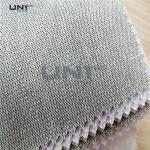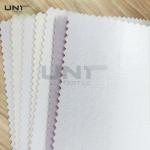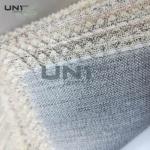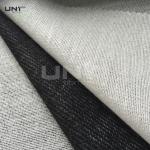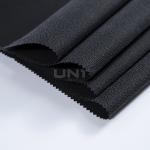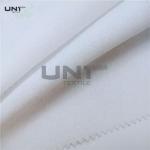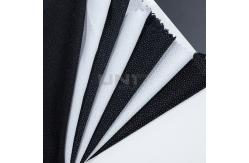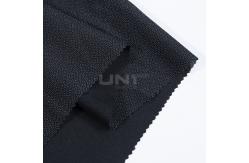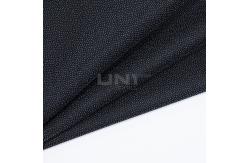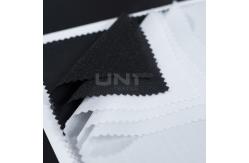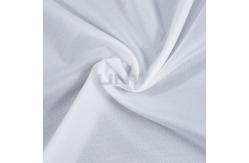Plain woven interlining is a type of textile material that plays a crucial role in garment
manufacturing by providing structure, stability, and shape. It is
made using a simple weave pattern where the warp and weft yarns are
interlaced at right angles to each other, creating a balanced and
even fabric. Plain woven interlining is one of the most commonly
used types of interlining because of its versatility, durability,
and ease of application in a wide range of garments and textile
products. What is Plain Woven Interlining?Plain woven interlining is typically made from a variety of fibers
such as cotton, polyester, nylon, or blends, and is available in
different weights, thicknesses, and finishes. The fabric is woven
in a simple over-under pattern, which gives it a smooth and uniform
texture. The interlining is often treated with a fusible adhesive
on one side, allowing it to bond to the fabric when heat and
pressure are applied. Benefits of Plain Woven InterliningStrength and Durability: The plain weave structure provides excellent strength and
durability, making it ideal for use in garments that require added
support. It can withstand wear and tear over time and provides
lasting performance. Versatility: Plain woven interlining is highly versatile and can be used with
a wide range of fabrics, from lightweight materials like cotton and
silk to heavier fabrics like wool and polyester. This makes it
suitable for various applications across different types of
garments. Support and Structure: Plain woven interlining helps improve the shape and structure of
garments. It is commonly used in areas such as collars, cuffs,
waistbands, and other parts of a garment that require extra support
and rigidity. Smooth Finish: The even texture of plain woven interlining ensures a smooth and
crisp finish on garments. It enhances the fabric's appearance by
preventing wrinkling and maintaining a neat, professional look. Breathability: Plain woven interlining made from natural fibers such as cotton
allows for good breathability, ensuring comfort for the wearer,
especially in clothing items that will be worn for extended
periods. Easy Application: When treated with fusible adhesive, plain woven interlining can
be easily bonded to the fabric with an iron or heat press,
providing a quick and efficient solution for adding structure to
garments.
Types of Plain Woven InterliningLightweight Plain Woven Interlining: Used for lightweight fabrics such as cotton, linen, and silk,
this type of interlining provides minimal support and is ideal for
garments like blouses, shirts, and dresses. Medium-weight Plain Woven Interlining: Suitable for medium-weight fabrics such as polyester blends,
denim, and some wool fabrics, this type of interlining is commonly
used for shirts, skirts, and trousers. Heavyweight Plain Woven Interlining: This type of interlining is thicker and provides stronger
support, making it ideal for outerwear such as jackets, coats, and
tailored garments. It is often used for fabrics like wool and
polyester blends. Stretch Plain Woven Interlining: Stretch plain woven interlining is designed for use with fabrics
that have some stretch, such as spandex or elastane blends. It
ensures that the interlining moves with the fabric without
compromising on support.
Applications of Plain Woven InterliningShirts and Blouses: Plain woven interlining is commonly used in shirt collars, cuffs,
and plackets, as it helps maintain the crisp and structured
appearance that is characteristic of formal shirts. Suit Jackets and Blazers: It is often used in tailoring, especially in areas like lapels,
collars, and the front panels of suits and blazers, to provide a
professional and sharp look. Outerwear: For outer garments like coats, jackets, and trench coats, plain
woven interlining adds structure and helps the fabric hold its
shape while providing support to more complex garment parts. Skirts and Trousers: Plain woven interlining is used in the waistbands, pleats, and
other structured areas of skirts and trousers to prevent sagging
and ensure the garment maintains its shape. Home Textiles: In home textile products like curtains, cushions, and upholstery,
plain woven interlining is used to provide additional weight and
structure, ensuring the products retain their shape over time. Fashion Accessories: Plain woven interlining is also applied in accessories like
handbags, belts, and hats to provide structure and durability.
How to Apply Plain Woven InterliningPre-wash Fabric: To avoid shrinkage after application, it is recommended to
pre-wash both the fabric and the plain woven interlining before
use. Cut to Size: Cut the plain woven interlining to the desired size, ensuring it
is slightly smaller than the fabric area to avoid visible edges. Heat Application: Place the fusible side of the interlining against the wrong side
of the fabric. Using an iron or heat press, apply moderate heat and
pressure to bond the interlining to the fabric. Ensure that the
temperature and timing are suitable for the fabric type to avoid
any damage. Cooling and Pressing: Allow the fabric to cool before pressing it again for a smooth,
professional finish.
ConclusionPlain woven interlining is a versatile and durable material that is
essential for adding support and structure to a wide range of
garments and textiles. Its simple, yet strong weave structure makes
it a reliable choice for a variety of applications, from shirts and
suits to outerwear and home textiles. By providing shape,
structure, and durability, plain woven interlining ensures that
garments maintain a neat and professional appearance throughout
their lifespan. With different weights and finishes available, it
can be customized to suit the specific needs of various fabric
types and garment designs |
